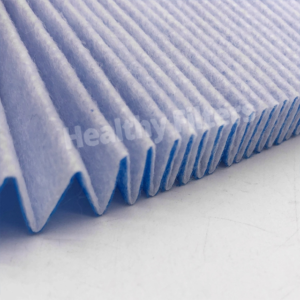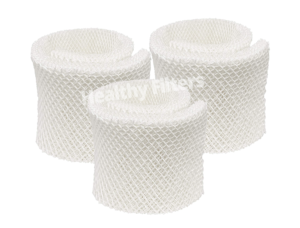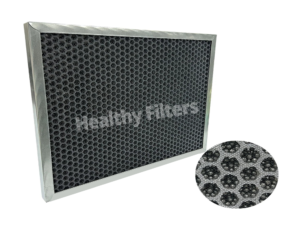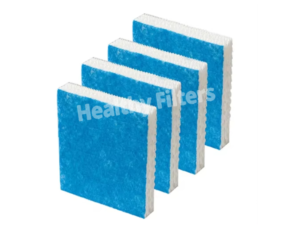Synthetic Fiber Pocket Filter F6 is a medium-high efficiency air filtration device that complies with EN 779:2012 and ISO 16890 standards. It is designed to intercept 0.5-5μm fine particles (such as bacteria, smoke, pollen and some aerosols). It adopts a high-density polyester fiber composite structure and an optimized bag layout. While maintaining low airflow resistance, it achieves F6-level filtration efficiency (corresponding to MERV 12-13). It is suitable for scenes with high cleanliness requirements such as medical, electronic manufacturing, and food processing. It is a key component to ensure air quality and equipment protection.
Core structure and technical parameters
Material and process
Filter material: electrostatically charged polyester fiber (PET) non-woven fabric, fiber diameter ≤2μm, progressive filtration is achieved through gradient density design (outer layer coarse efficiency + inner layer high efficiency), and surface anti-static treatment reduces secondary particle flying.
Bag structure: 8-16 V-shaped pleated filter bags, the effective filtration area is 4-7 times that of flat filter media, and the dust holding capacity is 600-1000g/m².
Sealing frame: galvanized steel or reinforced ABS plastic frame, temperature resistance range -30℃ to 70℃, the edge is sealed with polyurethane strips to ensure no side leakage.
Performance parameters
Filtration efficiency:
PM1.0 filtration efficiency ≥ 60% (ISO ePM1 60%+), PM2.5 ≥ 85% (ISO ePM2.5 85%+);
The interception rate of 0.5μm particles is ≥ 80% (EN 779 F6 standard).
Initial pressure difference: ≤70Pa (@ rated air volume), the operating energy consumption is 20% lower than that of traditional filter elements.
Humidity tolerance: ≤85% RH (optional hydrophobic coating, moisture-proof and mildew-resistant).
Core advantages
Advantage dimensions Specific performance User value
Efficient purification Significant interception ability for fine particles such as bacteria and smoke, close to the level of HEPA pre-filtration Improve the level of clean space (such as ISO Class 8 clean room)
Economic and energy-saving High dust holding capacity design, replacement cycle extended to 9-18 months Reduce consumables cost and maintenance frequency
Safe and environmentally friendly No glass fiber components, compliant with RoHS and REACH standards, can be incinerated Ensure personnel health, support green building certification (LEED/BREEAM)
Flexible adaptation Support customized size (thickness 50-600mm, number of filter bags 8-36 bags) Adaptive air volume range 1000-10,000m³/h
Typical application scenarios
Medical health:
Hospital operating room, ICU ward fresh air system, intercept bacteria and virus carriers, reduce infection risk;
Biological laboratory ventilation, protect precision instruments from particulate contamination.
Electronic manufacturing:
Semiconductor dust-free workshops, LCD production lines, control particles above 0.5μm, maintain ISO Class 7 cleanliness;
Data center air conditioning systems, prevent dust deposition from causing equipment overheating.
Food and pharmaceuticals:
Aseptic filling workshops, pharmaceutical factory HVAC systems, intercept microorganisms and dust, meet GMP certification requirements;
Dairy processing lines, prevent odor and foreign matter from mixing.
Business and transportation:
Airport terminals, high-speed rail station central air conditioning, improve indoor air quality (IAQ);
Museums, archives, protect cultural relics from dust erosion.
Selection and maintenance guide
Accurate selection
Air volume matching: select the number and depth of filter bags according to the system air volume (such as 5000m³/h corresponds to 12-16 bags, depth ≥300mm);
Pollution characteristics:
High microbial risk (such as hospitals): select antibacterial coating filter material (silver ion/copper ion impregnation);
High humidity environment (such as food factories): select hydrophobic treatment frame and filter bag.
Smart maintenance
Pressure difference monitoring: The recommended replacement threshold is the initial pressure difference × 2.5 (usually ≤175Pa) to avoid efficiency loss;
Cleaning suggestions: Surface dust can be cleaned with a vacuum cleaner, and water washing or high-pressure backwashing is prohibited (irreversible damage to the electrostatic layer);
Replacement cycle:
Low-load scenario (commercial building): 12-18 months;
High-load scenario (electronic workshop): 6-9 months.
Technological innovation and industry trends
Smart sensing: integrated pressure difference sensor and RFID chip, real-time upload of filter element life to the building management system (BMS);
Multifunctional composite: optional activated carbon interlayer (Hybrid model), simultaneous adsorption of formaldehyde, ozone and odor;
Sustainable upgrade: using recycled polyester fiber (rPET), carbon footprint reduced by 25%, in line with the EU Green Deal.
Synthetic fiber bag filter F6 takes **”high-efficiency interception, long-term durability, and intelligent adaptation”** as its core value, becoming the preferred solution in the field of medium and high-efficiency filtration. From medical purification to electronic manufacturing, it not only protects air quality, but also promotes the healthier and smarter upgrade of industrial and commercial spaces through technological innovation.





